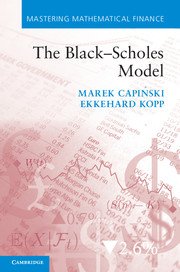5 - Path-dependent options
Published online by Cambridge University Press: 05 November 2012
Summary
Classical call and put options are examples of derivatives whose payoff depends on the stock price at exercise. We now present examples of options where payoff depends on the path. These are among the so-called exotic options. Instruments of this kind have become ever more prevalent in the markets in the past two decades. For our first class of such options we can still derive explicit closed-form pricing formulae, but such neat outcomes will become ever rarer as the complexity of the options increases, and one is forced, more and more, to rely on numerical approximation techniques. We remain in the Black-Scholes option pricing model, so our previous results apply here.
Barrier options
Barrier options have payoff functions that are simple modifications of the payoff of a call or put option: the call or put payoff has a cut-off point or barrier that depends on the maximum or minimum of the values of the underlying throughout the interval [0, T]. Its calculation involves analysis of the whole path, making barrier options path-dependent.
Since we can consider either a call or a put, the maximum or minimum of the stock price, and use the barrier L as a means either of ‘creating’ or ‘killing’ the payoff, there are eight types of option to consider. Fortunately, call-put parity reduces our pricing task by half, and we will also be able to price the remaining four options in pairs.
Information
- Type
- Chapter
- Information
- The Black–Scholes Model , pp. 107 - 132Publisher: Cambridge University PressPrint publication year: 2012
